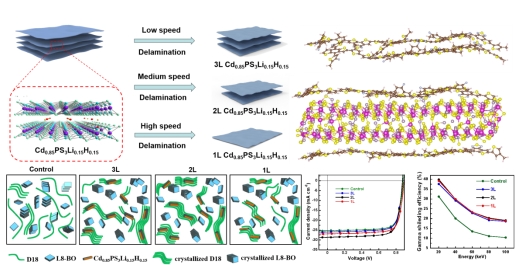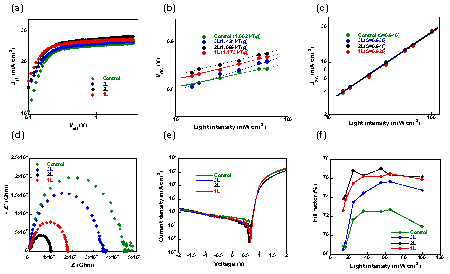Recently, the team of Professor Li Zhenye from the School of Mechanical Engineering of University of South China synthesized two-dimensional Cd0. 85PS 3Li 0. 15H0. 15 crystals with different layers by liquid phase exfoliation method, and found that the double-layer Cd0. 85PS 3Li 0. 15H0. 15 dopant can enhance the power of OPV conversion efficiency (PCE) and nuclear radiation shielding ability. Relevant research results were published in the internationally renowned journal Chemical Engineering Journal under the title "Layer-optimized Cd0. 85PS3Li0. 15H0. 15triggering donor crystallization for high performance organic photography with nuclear radiation shielding".
Over the past decade, OPV has shown great potential in the emerging PV field due to its low production cost, light weight, material abundance and mechanical flexibility. Although OPV has made significant progress in device engineering, and the highest certified PCE of OPV exceeds 19%, this PCE cannot meet the needs of large-scale commercialization of OPV. Two-dimensional crystals can be used as dopants to realize effective electron cascade transfer due to their excellent high carrier mobility, high absorption coefficient and suitable valence band position. As we all know, the number of layers of 2D crystals can significantly affect their optical and electrical properties, but the impact of the number of layers of 2D crystals on the performance of OPV devices has not been widely concerned and studied. Therefore, optimizing the number of 2D crystal layers and deeply understanding the impact of its number of layers on the OPV film-forming mechanism is crucial to achieving breakthroughs in OPV device performance.
In this work, the researchers synthesized 2D Cd0. 85PS 3Li 0. 15H0. 15 crystals with different layers by liquid phase exfoliation method, and explored the influence of 2D Cd0. 85PS 3Li 0. 15H0. 15 dopants with different layers on the molecular orientation of OPV active layer and device performance. Grazing incidence wide-angle X-ray scattering (GIWAXS) was used to investigate the effect of different layers of Cd0. 85PS 3Li0. 15H0. 15 dopants on the stacking structure of D18: L8-BO active layers. The results show that the active layer based on bilayer Cd0. 85PS 3Li. 15H0. 15 doping has the smallest π-π stacking distance. The crystallinity of D18 polymer was enhanced by doping Cd0. 85PS 3Li0. 15H0. 15 with bilayer dopant, which promoted the charge transport. Molecular dynamics simulations show that Cd0. 85PS 3Li. 15H0. 15 tends to be distributed in the domain of D18. Although increasing the number of Cd0. 85PS 3Li0. 15H0. 15 layers can improve its ability to adsorb D18, it also forms a greater steric hindrance in the domain of D18. The bilayer Cd0. 85PS 3Li. 15H0. 15 has balanced adsorption capacity and steric hindrance, which maximizes the induction of crystallization of D18, thereby significantly promoting charge transport and effectively suppressing bulk charge recombination in D18: L8-BO devices. As a result, the PCE based on the D18: L8-BO device increased from 17.57% to 19.59%, which is one of the highest PCE values for this OPV system. In addition, the bilayer Cd0. 85PS 3Li0. 15H0. 15 dopant can effectively enhance the nuclear radiation shielding ability of OPV.

Preparation of Cd0. 85PS 3Li0. 15H0. 15 Crystal with Different Layer Number; Relative Aggregation Trend, Molecular Dynamics Simulation, Photovoltaic Properties and Nuclear Radiation Shielding Properties of OPV Active Layer Doped with Cd0. 85PS 3Li0. 15H0. 15 Crystal
The researchers explored the physical mechanism of the action of 2D Cd0. 85PS 3Li0. 15H0. 15 dopants at different layers on OPV devices. The results show that the OPV device based on bilayer Cd0. 85PS 3Li0. 15H0. 15 doping can achieve equilibrium in promoting exciton generation and dissociation, without increasing trap-assisted monomolecular recombination, and can suppress bimolecular recombination of the device, thereby improving the device photocurrent. At the same time, the OPV device based on bilayer Cd0. 85PS 3Li 0. 15H0. 15 doping weakens the bulk charge recombination, effectively fills the trap of the D18: L8-BO active layer, and reduces the leakage current of the device, so that the OPV device based on bilayer Cd0. 85PS 3Li 0. 15H0. 15 doping has the largest fill factor.

Physical Mechanism of OPV Device Fabricated by D18: L8-BO Active Layer Doped with Cd0. 85PS 3Li0. 15H0. 15
This study shows that the layer number control of two-dimensional dopant Cd0. 85PS 3Li0. 15H0. 15 can simultaneously enhance the PCE and nuclear radiation shielding capabilities of OPV, which can provide theoretical and experimental basis for the development of nuclear radiation shielding-oriented organic photovoltaics. Professor Li Zhenye and Professor Ding Yufeng are the corresponding authors of the paper, postgraduate Zou Chuankai is the first author, and the School of Mechanical Engineering of USC is the first unit to sign the paper.